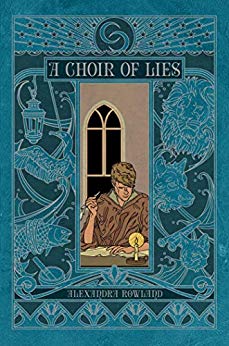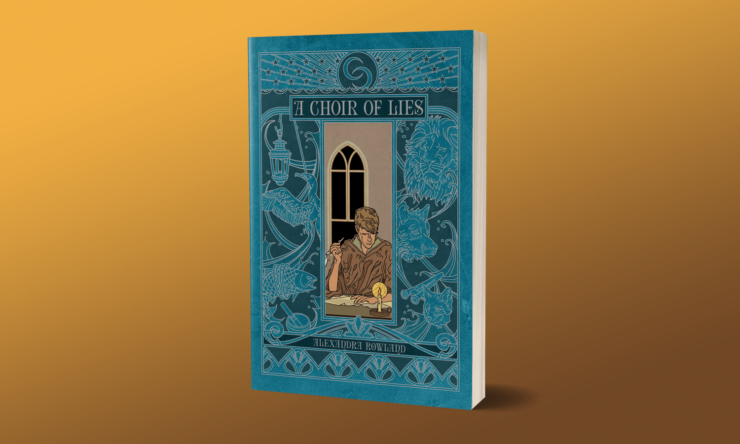In A Choir of Lies, Alexandra Rowland brings us back the world of Chants, but in the process completely calls into question what we learned about them in A Conspiracy of Truths
I think it is futile for me to discuss what A Choir of Lies does without discussing in depth what A Conspiracy of Truths does, and so readers who do not want to be spoiled for the first book probably should go read it first.
Ready? Good!
[Spoilers for A Conspiracy of Truths ahead!]
In A Conspiracy of Truths, we are introduced to Chants, a self-selected group of people who travel the world, collecting and telling stories. Our main characters, Chant (a name that all such people take when they fully become masters of the craft, their original name is no longer used) and Ylfing, wind up in the country of Nuryevet, where Chant runs afoul of the law, winds up in prison, and—with the power of stories, and the help of a few people outside the prison—manages to overthrow a society. It’s a book full of the power of stories, of language, and yes, of footnotes. In the course of that story, we get to learn a lot about the origin of Chants, refugees from a sunken homeland who, through their strong oral tradition, scrape a living—sometimes by the skin of their teeth. The novel ends with the potential of Chant settling down in Nuryevet and Ylfing, sweet, innocent, cinnamon roll Ylfing, moving off on his own, as a full fledged Chant, giving up his name and his homeland (“sinking it beneath the waves”).
In A Choir of Lies, the focus is on the former Ylfing, several years later. He has indeed sunk his homeland beneath the waves, given up his name and is now an hand-to-mouth Chant. But he feels very conflicted about the entire process. In Heyrland (a setting reminiscent of the heights of Early Modern Holland) he takes a job as a translator, helping to create a booming market for an odious but beautiful plant. And as the prices and money spent on these blooms increases and increases to the benefit of his employer, the dangers of a tulip-mania start to become painfully clear to someone who has already seen a society torn apart by words. And most especially when it becomes clear that the mania for stars-in-the-marsh cannot possibly be sustained.
But there is more going on than just that. The book, such as we have, is annotated, by someone who knows about Chants and who and what they are. And has definite ideas that what Ylfing is saying about Chants and what they do…is extremely and utterly wrong. Throughout the book, “Mistress Chant” extensively comments on what is written down, giving her own perspective, and criticism, and it is sometimes sharp indeed. And it challenges everything we think we know about Chants and how they work, their organization, their lifestyle and indeed, their very purpose. Indeed, throughout the book, Mistress Chant is horrified by the way and what Ylfing was taught.
Reading A Choir of Lies is like sitting in a room with two full length mirrors, reading the book and yet seeing reflections of yourself doing the same thing. It’s an unnerving experience, having the reflections mimic your actions, and comment on them at the same time by their presence. The reflections are inescapable, and to take as a whole, necessary to a full appreciation of the text and what it is trying to do. The footnotes by Mistress Chant do resurrect the older/younger dynamic of the first novel, but reversing it, making the center the younger protagonist telling the tale, and having the older character essential, but usually on the periphery. She’s not quite as detached as a Greek Chorus, Ylfing/Chant’s reactions to her are given on both sides of the conversation. Mistress Chant has two apprentices of her own, but they are very incidental to the story in the end.
But the novel goes even further with the metatextual form, making it clear that this is a collection of pages, a book, that Mistress Chant has been given by Ylfing/Chant, and her annotations are sometimes not linear, expressing indications that she has “come back” to a point in the narrative from later on the text. Even more so, there are words crossed out, chapters lost, a chapter burned in the fire, and Mistress Chant’s own belief that a Chant writing a story down is a terrible thing, to “pin the story like a butterfly”. It is a strange thing to read a book, to consume a story, with a commentator who believes ardently that the act of writing a story down that I can later read is a vile act. There are also musings on language and the uses and limitations of language, both by Ylfing/Chant and in commentary, Mistress Chant.
And then there are the stories within the book. The stories are not quite as front and center as they are in A Conspriacy of Lies, and Mistress Chant is absolutely horrified by the idea that Ylfing is writing them out, one in particular is a heretical act to her. These stories don’t quite essentially underpin the narrative as the first novel does, since Chant is using stories to save his life. Ylfing’s use of story is different, here. We are told of some of the stories he tells that fuel the tulip mania, and the stories he tells here do illuminate character, but with so much else going on, the book doesn’t quite rest on the told tales as much as the first book does.
Buy the Book


A Choir of Lies
Speaking of which, there are a couple of braided stories within the pages of the novel. There is the aforementioned tulia mania story that propels a lot of the narrative. Once I realized that was where the novel was going, I could feel the beats out of that narrative in a straightforward manner (as opposed to the twistier Xanatos speed chess that underlies the plot of A Conspiracy of Lies). However the novel also has a love story in it, with all the pain that one might expect poor Ylfing to undergo in the process. And then there is the story that is happening in and around Ylfing that he just doesn’t see. He describes events and encounters he does not know the provenance of, and the nature of which our commentator, Mistress Chant, isn’t quite clear on, either. But it was fascinating for me, as a reader to try and piece together the perspective and knowledge of Mistress Chant to try and figure out just what really happens to Ylfing/Chant.
The worldbuilding focuses mainly on Heyrland, which does feel like the aforementioned Holland, down to the Dikes and the spirit of community needed to sustain them. There is a definite theme of “it takes a village” to make a society, one that is not only implicit in the text but one that is commented upon. We get some more background on the Chants, at least from Mistress Chant’s point of view. We don’t get much more of a sense of the world than we did in Conspiracy . I would like to know more about how places set together. Like the previous novel, it still does remind me a lot of the “Unbeheaded King” universe of L Sprague de Camp. Not a tremendous amount of magic, but oh so clearly a secondary world that is aware of its parts. There is a cosmopolitan assumption in the two novels that I really like. Worlds where the villages, towns and cities that the heroes visit never seem to have any real sense of the world beyond their walls bore me. It’s much better story material, I think, to walk into a tavern, let slip you are from the Marske Timocracy, and your drinking companion’s opinion suddenly changes…and plot happens!
I am left at the end of the novel with more questions than answers. Who in the end is telling the truth about what Chants are, what they are supposed to be, how they are supposed to act, what they are supposed to do? We only have two data points—Chant in Conspiracy, nearly ascetic, very agnostic, living off of stories and thin gruel, a wandering storytellers life. And Mistress Chant in Choir, a Chant that is very much interested in comfort and living well, in being a devotee of the God, drawing his attention in the process. This novel deconstructs almost everything we learn in A Conspiracy of Truths, casting that entire novel, and the lifestyle that Chant in that novel lives. But who is right in the end? Which is the “true” way of being a Chant? And is there even such a thing as a “True way” of Chanting? The books together are amazingly and delightfully unclear on that question, leaving it for the reader to ultimately decide.
My decision on whether I enjoy the metafictional, metatextual, cosmopolitan, erudite and engaging fantasy that Alex Rowland creates is clear–I most certainly do. There seems to be a mini-boom of fantasy fiction that engages within itself by means of voice, point of view, and, yes, footnotes —A Conspiracy of Truths and A Choir of Lies fit among them quite nicely.
A Choir of Lies is available from Saga Press.
An ex-pat New Yorker living in Minnesota, Paul Weimer has been reading sci-fi and fantasy for over 30 years. An avid and enthusiastic amateur photographer, blogger and podcaster, Paul primarily contributes to the Skiffy and Fanty Show as blogger and podcaster, and the SFF Audio podcast. If you’ve spent any time reading about SFF online, you’ve probably read one of his blog comments or tweets (he’s @PrinceJvstin).










